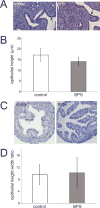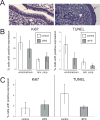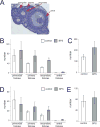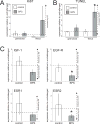Developmental exposures to bisphenol S, a BPA replacement, alter estrogen-responsiveness of the female reproductive tract: a pilot study
- PMID: 31231671
- PMCID: PMC6588183
Developmental exposures to bisphenol S, a BPA replacement, alter estrogen-responsiveness of the female reproductive tract: a pilot study
Abstract
Developmental exposures to bisphenol A (BPA), an estrogen receptor agonist, can disrupt development of the female reproductive tract in rodents and non-human primates. Due to an increased public knowledge of negative health effects associated with BPA exposure, BPA has begun to be phased out of many consumer products and in some cases it has been replaced with structurally similar compounds including bisphenol S (BPS). This study examined CD-1 mice exposed to a low dose of BPS during early development (200 µg/kg/day from gestational day 8 until postnatal day 19). BPS altered expression of estrogen-responsive genes in both the uterus and ovary, and induced increases in ovarian follicular development in pre-pubertal females evaluated at postnatal day 22. Prior studies have revealed that developmental exposures to environmental chemicals including BPA alter the response of animals to hormonal or carcinogen challenges experienced later in life. To evaluate whether early life exposures to BPS alter responses of females to an estrogen challenge, additional females were exposed to ethinyl estradiol from postnatal day 19 through postnatal day 21. BPS-treated females responded abnormally to this estrogen challenge, displaying heightened responses in the uterus and diminished responses in the ovary. Although additional studies are needed to characterize the mechanisms by which BPS alters the female reproductive tract, this pilot study provides evidence that a common BPA replacement chemical may have endocrine disrupting properties.
Keywords: apoptosis; endocrine disruptor; estrogen receptor; ethinyl estradiol; ovarian follicles; proliferation; puberty; uterine endometrium.
Figures








Similar articles
-
Bisphenol S alters development of the male mouse mammary gland and sensitizes it to a peripubertal estrogen challenge.Toxicology. 2019 Aug 1;424:152234. doi: 10.1016/j.tox.2019.06.005. Epub 2019 Jun 12. Toxicology. 2019. PMID: 31201878 Free PMC article.
-
Data describing effects of perinatal exposure to bisphenol S on a peripubertal estrogen challenge in intact female CD-1 mice.Data Brief. 2019 Mar 20;25:103862. doi: 10.1016/j.dib.2019.103862. eCollection 2019 Aug. Data Brief. 2019. PMID: 31245508 Free PMC article.
-
Developmental exposure to endocrine disrupting chemicals alters the epigenome: Identification of reprogrammed targets.Gynecol Obstet Res. 2016 Jul;3(1):1-6. doi: 10.17140/GOROJ-3-127. Epub 2016 May 3. Gynecol Obstet Res. 2016. PMID: 27478869 Free PMC article.
-
Bisphenol A and human health: a review of the literature.Reprod Toxicol. 2013 Dec;42:132-55. doi: 10.1016/j.reprotox.2013.08.008. Epub 2013 Aug 30. Reprod Toxicol. 2013. PMID: 23994667 Review.
-
Risk Evaluation of Endocrine-Disrupting Chemicals: Effects of Developmental Exposure to Low Doses of Bisphenol A on Behavior and Physiology in Mice (Mus musculus).Dose Response. 2015 Oct 29;13(4):1559325815610760. doi: 10.1177/1559325815610760. eCollection 2015 Oct-Dec. Dose Response. 2015. PMID: 26740806 Free PMC article. Review.
Cited by
-
Bisphenol S Alters the Lactating Mammary Gland and Nursing Behaviors in Mice Exposed During Pregnancy and Lactation.Endocrinology. 2017 Oct 1;158(10):3448-3461. doi: 10.1210/en.2017-00437. Endocrinology. 2017. PMID: 28977596 Free PMC article.
-
Bisphenol-A analogue (bisphenol-S) exposure alters female reproductive tract and apoptosis/oxidative gene expression in blastocyst-derived cells.Iran J Basic Med Sci. 2020 May;23(5):576-585. doi: 10.22038/IJBMS.2020.40893.9664. Iran J Basic Med Sci. 2020. PMID: 32742594 Free PMC article.
-
Bisphenol S Impairs Invasion and Proliferation of Extravillous Trophoblasts Cells by Interfering with Epidermal Growth Factor Receptor Signaling.Int J Mol Sci. 2022 Jan 8;23(2):671. doi: 10.3390/ijms23020671. Int J Mol Sci. 2022. PMID: 35054855 Free PMC article.
-
Handling of thermal paper: Implications for dermal exposure to bisphenol A and its alternatives.PLoS One. 2017 Jun 1;12(6):e0178449. doi: 10.1371/journal.pone.0178449. eCollection 2017. PLoS One. 2017. PMID: 28570582 Free PMC article.
-
Developmental Programming: Physiological Impacts of Prenatal Melatonin Administration on Reproductive Capacity and Serum Triiodothyronine of Adult Female Offspring Rat Born to Moms Exposed to Bisphenol A During Pregnancy.Reprod Sci. 2021 Jul;28(7):1956-1966. doi: 10.1007/s43032-020-00452-8. Epub 2021 Jan 19. Reprod Sci. 2021. PMID: 33469879
References
-
- Mandrup KR, Jacobsen PR, Isling LK, et al. Effects of perinatal ethinyl estradiol exposure in male and female Wistar rats. Reprod Toxicol. 2013;42:180–91. - PubMed
-
- Soto AM, Rubin BS, Sonnenschein C. Endocrine disruption and the female. In: Gore A, editor. Endocrine-Disrupting Chemicals. Totowa, N.J.: Humana Press; 2007.
-
- McLachlan JA. Commentary: prenatal exposure to diethylstilbestrol (DES): a continuing story. Int J Epidemiol. 2006;35(4):868–70. - PubMed
-
- Herbst AL, Ulfelder H, Poskanzer DC. Adenocarcinoma of the vagina. Association of maternal stilbestrol therapy with tumor appearance in young women. New England Journal of Medicine. 1971;284(15):878–81. - PubMed
Grants and funding
LinkOut - more resources
Full Text Sources
